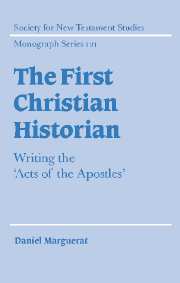Book contents
- Frontmatter
- Contents
- Preface
- 1 How Luke wrote history
- 2 A narrative of beginnings
- 3 The unity of Luke–Acts: the task of reading
- 4 A Christianity between Jerusalem and Rome
- 5 The God of Acts
- 6 The work of the Spirit
- 7 Jews and Christians in conflict
- 8 Ananias and Sapphira (Acts 5. 1–11): the original sin
- 9 Saul's conversion (Acts 9; 22; 26)
- 10 The enigma of the end of Acts (28. 16–31)
- 11 Travels and travellers
- Bibliography
- Index of passages
Preface
Published online by Cambridge University Press: 22 September 2009
- Frontmatter
- Contents
- Preface
- 1 How Luke wrote history
- 2 A narrative of beginnings
- 3 The unity of Luke–Acts: the task of reading
- 4 A Christianity between Jerusalem and Rome
- 5 The God of Acts
- 6 The work of the Spirit
- 7 Jews and Christians in conflict
- 8 Ananias and Sapphira (Acts 5. 1–11): the original sin
- 9 Saul's conversion (Acts 9; 22; 26)
- 10 The enigma of the end of Acts (28. 16–31)
- 11 Travels and travellers
- Bibliography
- Index of passages
Summary
Luke, not Eusebius of Caesarea, was the first Christian historian. In antiquity, he was the first to present a religious movement in a historiographical manner. As for all historians, the aim of Luke is identity. When he recounts the birth of Christianity, its undesirable rupture with Judaism, and then the universal adventure of the Word, the author of Acts offers the Christianity of his time, an understanding of its identity through a return to its origins.
My reading of the historiographical work of Luke combines two procedures of investigation: historical criticism and narrative criticism. I am convinced that the understanding of a biblical writing requires that it be immersed in the historical milieu of its production (this is the epistemological credo of the historical-critical method). Constantly, in the course of the study, I shall be examining the culture and codes of communication of the ancient Mediterranean world to which Luke and his readers belong. However, the author of Acts is also a storyteller; the tools of narrative criticism help to identify the strategy of the narrator, the organization of the story, and the programmatic clues for reading that he has sown in his text.
One of the insights defended in this book is that we cannot reach the theology the author has written into his work without adopting the itinerary he imposes on his readers; this itinerary is the twists and turns of the narrative.
- Type
- Chapter
- Information
- The First Christian HistorianWriting the 'Acts of the Apostles', pp. xi - xiiPublisher: Cambridge University PressPrint publication year: 2002

